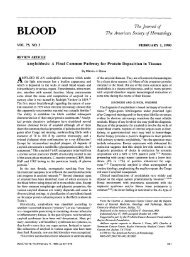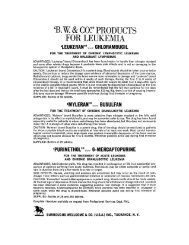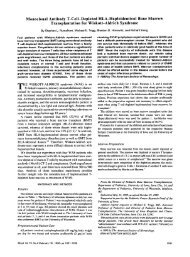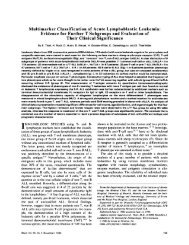Platelet Life Span in Normal, Splenectomized and ... - Blood
Platelet Life Span in Normal, Splenectomized and ... - Blood
Platelet Life Span in Normal, Splenectomized and ... - Blood
Create successful ePaper yourself
Turn your PDF publications into a flip-book with our unique Google optimized e-Paper software.
From www.bloodjournal.org by guest on April 28, 2015. For personal use only.<br />
<strong>Platelet</strong> <strong>Life</strong> <strong>Span</strong> <strong>in</strong> <strong>Normal</strong>, <strong>Splenectomized</strong><br />
<strong>and</strong> Hyperspienic Rats<br />
By PETER F. HJORT AND HELEN PAPUTCHIS<br />
T HE PLATELETS are produced <strong>in</strong> the bone marrow, circulate <strong>in</strong> the<br />
blood for a number of days, <strong>and</strong> then disappear. Their eventual fate<br />
is not known. Conceivably, the spleen might be an important site of platelet<br />
destruction, <strong>and</strong> the <strong>in</strong>creased platelet level follow<strong>in</strong>g splenectomy might<br />
be due to a decreased destruction of platelets. Likewise, the decreased level<br />
<strong>in</strong> hypersplenism might be due to an <strong>in</strong>creased destruction.<br />
One approach to this problem is to label platelets <strong>in</strong> vitro, <strong>and</strong> then study<br />
their localization <strong>in</strong> the normal animal. The spleen conta<strong>in</strong>s a considerable<br />
amount of the label <strong>in</strong> such experiments,14 apparently support<strong>in</strong>g the concept<br />
that the spleen normally destroys a large fraction of platelets. However, this<br />
evidence may be criticized on the grounds that <strong>in</strong> vitro label<strong>in</strong>g <strong>and</strong> h<strong>and</strong>l<strong>in</strong>g<br />
may damage the platelets <strong>and</strong> lead to abnormal tissue localization. The body<br />
may h<strong>and</strong>le its own <strong>in</strong>tact platelets differently.<br />
Another approach to the problem is to study the possible <strong>in</strong>fluence of the<br />
spleen on the platelet life span by <strong>in</strong> vivo tagg<strong>in</strong>g. If the spleen is the ma<strong>in</strong><br />
destructor of platelets, their life span might be prolonged after splenectomy,<br />
all(l shortened <strong>in</strong> hypersplenism. Follow<strong>in</strong>g this approach, we have found<br />
the platelet life span to be the same <strong>in</strong> normal, splenectomized, <strong>and</strong> hypersplenic<br />
rats.<br />
MATERIALS AND METHODS<br />
Male Sprague-Dawley rats were used. The average weight was 375 Gm. (290 to 485<br />
Gm. ) <strong>and</strong> was the same <strong>in</strong> the normal as <strong>in</strong> the abnormal groups. Splenecto<strong>in</strong>y was done<br />
under ether anesthesia, <strong>and</strong> all rats recovered promptly without suppuration. Shamsplenectomy<br />
was done on control animals <strong>in</strong> a similar manner, a piece of omentum be<strong>in</strong>g<br />
removed <strong>in</strong>stead of the spleen. Hypersplenism was produced by <strong>in</strong>jections of methylcellulose.5<br />
Each rat was given 1.95 Gm. of methylcellulose over 24 weeks; 39 <strong>in</strong>traperitoneal<br />
<strong>in</strong>jections of 2 ml. 2.5 per cent Methocel#{176} ( 400 centipoise ). No rats died, hut toward the<br />
end of the experiment they lost weight <strong>and</strong> appeared chronically ill.<br />
Label<strong>in</strong>g of platelets-The platelets were labeled <strong>in</strong> vivo by an <strong>in</strong>tramuscular <strong>in</strong>jection<br />
of radioactive diisopropylfluorophosphate (DFP3) f6 <strong>in</strong> water-free propylene glycol. The<br />
specific activity at the time of <strong>in</strong>jection was 165 to 188 jtc. per iig. Tile <strong>in</strong>jected dose was<br />
planned to be 400 sg. of DFP32 per Kg. rat, but <strong>in</strong> retrospect the dose was estimated to be<br />
at most 130 g. per Kg. The reason for this discrepancy is that our analyses of the DFPS2<br />
preparations differed from those of the producer. We measured the I)FP content by a<br />
Seattle,<br />
From the Department of Medic<strong>in</strong>e, University of Wash<strong>in</strong>gton School of Medic<strong>in</strong>e,<br />
Wash.<br />
This <strong>in</strong>vestigation was supported by a research grant from the American Cancer Society<br />
( MKI-2A).<br />
Submitted Apr. 27, 1959; accepted for publication June 28, 1959.<br />
#{176}DowChemical Company, Midl<strong>and</strong>, Mich.<br />
t Mann<strong>in</strong>g Research Laboratory, 27 Jlajdw<strong>in</strong> Road, Valthani, Mass,<br />
45
From www.bloodjournal.org by guest on April 28, 2015. For personal use only.<br />
46 HJORr AND PAPUTCHIS<br />
nlotlification of the method of Marsh <strong>and</strong> Neale,7 <strong>and</strong> correlated the results with the total<br />
phosphonis <strong>in</strong> the preparations. These two determ<strong>in</strong>ations agreed closely, <strong>and</strong> <strong>in</strong>dicated that<br />
the preparations conta<strong>in</strong>ed only one-third or less of the stated DFP content. The purity <strong>in</strong><br />
terms of phosphorus was 78 per cent or bettcr.<br />
Count<strong>in</strong>g of platelets-The method of Brecher et al.8 was used <strong>and</strong> each sample was<br />
ounted <strong>in</strong> duplicate. The coefficient of variation as determ<strong>in</strong>ed from 306 duplicate<br />
counts was 6.8 per cent.<br />
Glassware-All glassware was freshly coated with silicone.’<br />
Collection of blood-The rat was anesthetized with ether. As it stopped breath<strong>in</strong>g, the<br />
ai)dOnlen was opened <strong>and</strong> blood collected from the vena cava. A 10 ml. syr<strong>in</strong>ge with a 21<br />
gage needle coatetl with NIonocote Ef was used. The syr<strong>in</strong>ge conta<strong>in</strong>ed 0.4 ml. of a 5<br />
per cent solution of tlisodium vcrsenatef <strong>in</strong> water, adjusted to pH 6.5 The blood as collected<br />
by slow suction for about 20 seconds; the average amount obta<strong>in</strong>ed was 8.1 ml.<br />
( 5.4 to 1 1 . 1 nil. ) . \Vith slower aspiration, more blood coultl be obta<strong>in</strong>ed, but this led to<br />
clump<strong>in</strong>g of the platelets.<br />
ISolatlOfl of platelets.-DFP is not a specific platelet label : 24 hours after the <strong>in</strong>jection<br />
the platelets carried only about 0.3 per cent of the total activity <strong>in</strong> whole blood. The<br />
isolation procedure must therefore give a high yield of uncontanl<strong>in</strong>atetl, but not necessarily<br />
viable, platelets. By differential centrifugation of undiluted rat blood only 20 to 30 per cent<br />
of the platelets were isolateti. Dextran <strong>in</strong>creased the yield, but also the contam<strong>in</strong>ation with<br />
red cells. Dilution with sal<strong>in</strong>e proved to be the most convenient way to facilitate the separation<br />
of platelets, <strong>and</strong> the follow<strong>in</strong>g methotl was used.<br />
The blood collected was transferretl <strong>in</strong>to two 15 ml. gratluated tul)es, conta<strong>in</strong><strong>in</strong>g 3 to<br />
5 1131. each. Two to three ml. of 0.9 per cent sal<strong>in</strong>e were added to each tube, <strong>and</strong> the<br />
tui)eS were centrifuged at 800 rpm ( 150x g. ) for 20 m<strong>in</strong>utes at 20 C. The platelet-rich<br />
supernatant was cOliecte(l with a capillary pipet. Gentle suction as used, <strong>and</strong> care was<br />
taken not to disturb the red cells. However, the loose upper layer of the buffy ciat was<br />
collected, s<strong>in</strong>ce it conta<strong>in</strong>ed masses of platelets <strong>and</strong> only occasional white cells. Another<br />
2 to 3 ml. of sal<strong>in</strong>e were then added to the rema<strong>in</strong><strong>in</strong>g red cells, <strong>and</strong> the tubes were<br />
centrifuged at 650 rpm ( lOOx g. ) for 20 m<strong>in</strong>utes at 20 C. The supernatant was col-<br />
Icetetl <strong>in</strong> the same manner <strong>and</strong> added to the first supernatant. The volume of the comb<strong>in</strong>ed<br />
supernatants was measured, <strong>and</strong> the number of platelets, red <strong>and</strong> white cells counted.<br />
The platelet-rich mixture of plasma <strong>and</strong> sal<strong>in</strong>e was then centrifuged at 3000 rpm. ( 2100X<br />
g. ) for 30 m<strong>in</strong>utes at 20 C. <strong>in</strong> a 40 ml. centrifuge tube, <strong>and</strong> the supernatant decanted. The<br />
supernatant was practically free of platelets. The platelet button was washed three times<br />
<strong>in</strong> 10 ml. portions of sal<strong>in</strong>e.<br />
The centrifuge tubes must conta<strong>in</strong> about the same amount of blooti each time, otherwise<br />
the effective radius <strong>and</strong> hence the centrifugal force will vary too much. An optimal<br />
amount of sal<strong>in</strong>e must be used ( 2.5 to 3 ml. sal<strong>in</strong>e to 4 ml. blood ) , s<strong>in</strong>ce too little sal<strong>in</strong>e<br />
decreased tile yield, anti too much <strong>in</strong>creased the contam<strong>in</strong>ation with red cells. If low<br />
temperature is useti, the centrifugal force must be <strong>in</strong>creased. To <strong>in</strong>sure a constant<br />
high yield, it was necessary to carry out two successive separations. In one series, for<br />
<strong>in</strong>stance, the first separation gave an average yield of 63 per cent ( 44 to 85 per cent ) . The<br />
platelets from the second separation brought the yield to 74 per cent (61 to 88 per cent).<br />
Red <strong>and</strong> white cell contam<strong>in</strong>ation was consistently low, piovided the pipett<strong>in</strong>g was carefully<br />
done ( table 1 ). The contam<strong>in</strong>ation with plasma was studied by measur<strong>in</strong>g the<br />
radioactivity of tile wash waters. The fourth wash water was always free of radioactivity,<br />
<strong>and</strong> three wash<strong>in</strong>gs were therefore considered adequate.<br />
Mecansrenient of tile radioactivity-The platelets were f<strong>in</strong>ally resuspended <strong>in</strong> three<br />
drops of sal<strong>in</strong>e, hydrolyzed for 30 m<strong>in</strong>utes at 100 C. <strong>in</strong> 0.3 ml. of 30 per cent sodium<br />
hydroxide, <strong>and</strong> transferred quantitatively to a count<strong>in</strong>g planchet. One ml. nonradioactive<br />
O537 l)ri Film, General Electric.<br />
fArnlour Company, Chicago, Ill.<br />
Abbott Laboratories, North Chicago, Ill.
From www.bloodjournal.org by guest on April 28, 2015. For personal use only.<br />
PLATELET LIFE SPAN IN RATS 47<br />
_____________________________<br />
TABLE 1 -Results of 1 03 Consecutive Isolations ofPiateletsfroni Rat <strong>Blood</strong><br />
Average<br />
Range<br />
- Yield of platelets %: 70 50-91<br />
Contam<strong>in</strong>ation with red cells ( No.<br />
of red cells per 100,000 platelets ) : 1.2 0-14<br />
Contam<strong>in</strong>ation with white cells ( No.<br />
of white cells per 100,000 platelets ) : 0.9 0-4<br />
blood was added, the sample was dried at room temperature anti counted <strong>in</strong> an endw<strong>in</strong>tlow<br />
Greiger Mueller counter. A total of 4096 counts was cOIlll)ik-tl for each saiiiple.<br />
The background radioactivity was 24 to 26 counts per m<strong>in</strong>ute. Twenty-four hours after the<br />
<strong>in</strong>jection of DFP, the platelet samples gave 72 to 170 net counts per m<strong>in</strong>ute. The radioactivity<br />
was related to the total number of <strong>Platelet</strong>s <strong>in</strong> the comb<strong>in</strong>ed supernatants. No<br />
correction was made for the contam<strong>in</strong>ation with red anti white cells, s<strong>in</strong>ce on an average<br />
there was only one retl cell anti one white cell per 100,000 platelets ( see table 1 ).<br />
RESULTS<br />
<strong>Platelet</strong> life span <strong>in</strong> normal (111(1 splenectonhize(l rats-Thirty-six rats were<br />
used, one-half of which were splenectomized <strong>and</strong> the other half shamoperated.<br />
The rats were operated upon 14 days prior to the <strong>in</strong>jection of<br />
DFp:12. At <strong>in</strong>tervals after the <strong>in</strong>jection of DFP3, two rats were killed <strong>in</strong> each<br />
group, <strong>and</strong> the radioactivity of the platelets was measured.<br />
The number of platelets <strong>in</strong> whole blood was slightly, but significantly,<br />
higher (0.025 < P < 0.05) <strong>in</strong> the splenectomized group: 1,286,000 platelets<br />
per cu.mm. ( 1,032,000 to 1,590,000 ) as compared to 1,191,000 ( 1,031,000 to<br />
1,329,000 ) <strong>in</strong> the normal group.<br />
The platelet radioactivity decreased from day to day <strong>in</strong> both groups. The<br />
po<strong>in</strong>ts fit an exponential curve better than a straight l<strong>in</strong>e ( fig. 1 ) . In this<br />
diagram each po<strong>in</strong>t corresponds to one rat. In figure 2, each po<strong>in</strong>t represents<br />
the average of a pair of rats, <strong>and</strong> the two l<strong>in</strong>es are fitted by the method of<br />
least squares. There is no significant difference between the slopes of these<br />
two l<strong>in</strong>es ( P = 0.65 ) , suggest<strong>in</strong>g that the platelet life span is essentially<br />
the same <strong>in</strong> both groups.<br />
<strong>Platelet</strong> life s-pan <strong>in</strong> normal <strong>and</strong> hyperspienic rats-Forty rats were used;<br />
one-half was made hypersplenic, <strong>and</strong> the other was untreated. At the time<br />
of sacrifice the weight was similar <strong>in</strong> both groups, b:it the spleens were on an<br />
average six times heavier <strong>in</strong> the hypersplenic group: 4.42 Gm. ( 3.15 to 6.31<br />
Gm. ) versus 0.69 Gm. ( 0.46 to 0.93 Gm. ) . The hypersplenic rats were<br />
anemic; their average hematocrit was 37.7 ( 33.0 to 42.0) versus 45.9 ( 43.8<br />
to 50.0 ) <strong>in</strong> the normal group. They also had a slight, but significant ( P <<br />
0.01 ) thrombocytopenia : 780,000 platelets per cu.mm. ( 542,000 to 1,046,000)<br />
compared to 966,000 ( 721,000 to 1,144,000) <strong>in</strong> the normal group.<br />
Both groups were <strong>in</strong>jected with DFP:12 at the same time, <strong>and</strong> two rats <strong>in</strong><br />
group were killed at <strong>in</strong>tervals after the <strong>in</strong>jection. Figure 3 gives the<br />
I)lttelet radioactivity of the hvo groups. The data are plotted as <strong>in</strong> figure 2.<br />
each po<strong>in</strong>t is the average of two rats, <strong>and</strong> the l<strong>in</strong>es are fitted by the method<br />
of least squares. Aga<strong>in</strong>, there is no significant difference <strong>in</strong> the slope of
From www.bloodjournal.org by guest on April 28, 2015. For personal use only.<br />
48 HJORT AND PAPUTCHIS<br />
.<br />
01<br />
8 tO 2<br />
Days After Injection<br />
FIG. 1.-<strong>Platelet</strong> ratlioactivity after <strong>in</strong>jection of I)FP:5 <strong>in</strong> norusal <strong>and</strong> splenectomized rats.<br />
The same data are plotted on regular paper ( left ) anti on semilogarithmic paper ( right).<br />
Each po<strong>in</strong>t represents one rat; #{149} = nornial rats, <strong>and</strong> X = splenectomized rats. The open<br />
circles give the average for the four daily determ<strong>in</strong>ations.<br />
the two l<strong>in</strong>es ( P = 0.17 ), suggest<strong>in</strong>g that the platelet life span is the same<br />
ifl both groups.<br />
DISCUSSION<br />
The disappearance curve for labeled platelets is most often reported as a<br />
straight l<strong>in</strong>e, suggest<strong>in</strong>g a disappearance by senescence.5 However, some<br />
workers f<strong>in</strong>d an exponential curve, suggest<strong>in</strong>g a r<strong>and</strong>om destruction.’2<br />
Figure 1 shows that our data do not exactly fit either of these two types,<br />
s<strong>in</strong>ce the curves level off at an activity equal to 10 to 20 per cent of the 24<br />
hour value. Other workers6’3 also mention such residual activity. This might<br />
i)e expla<strong>in</strong>ed either by contam<strong>in</strong>ation, or by a prolonged period of label<strong>in</strong>g.<br />
The residual activity is not due to contam<strong>in</strong>ation with plasma, s<strong>in</strong>ce plasma<br />
is virtually <strong>in</strong>active eight days after the <strong>in</strong>jection; <strong>and</strong> contam<strong>in</strong>ation with<br />
reti <strong>and</strong> white cells was ruled out by microscopic exam<strong>in</strong>ations. Therefore,<br />
we believe that there is a prolonged period of label<strong>in</strong>g. This is not due to a<br />
slow release of DFP32 from the site of <strong>in</strong>jection, s<strong>in</strong>ce we found similar curves<br />
after <strong>in</strong>traperitoneal <strong>in</strong>jections. A reutilization of the label is held to be<br />
impossible,14 <strong>and</strong> we have confirmed that diisopropyl phosphate (DIP32)<br />
does not label blood cells. Therefore, we believe that the prolonged label<strong>in</strong>g<br />
is due to a gradual release of labeled platelets, probably from megakaryocytes.<br />
If this is so, only the first parts of our curves reflect the life span of the<br />
platelets <strong>in</strong>itially labeled <strong>in</strong> the circulation. Figure 1 shows that the data fit a
From www.bloodjournal.org by guest on April 28, 2015. For personal use only.<br />
PLATELET LIFE SPAN IN RATS 49<br />
1o,<br />
15#{149}<br />
S<br />
NORMAL<br />
RATS<br />
S--S SPLENECTOMIZED RATS<br />
Sc<br />
‘1<br />
Li<br />
2 4 6 8 10<br />
DAYS AFTER INJECTION<br />
FIG. 2.-<strong>Platelet</strong> radioactivity after <strong>in</strong>jection of DFP32 <strong>in</strong>to normal <strong>and</strong> splenectomized<br />
rats. Each po<strong>in</strong>t represents the average of two rats. The l<strong>in</strong>es are fitted by the method<br />
of least squares. In the normal group, the slope of the l<strong>in</strong>e corresponds to a half-life of<br />
3.0 days, with 2.4 to 4.0 days as 95 per cent confidence limits. In the splenectomized<br />
group, the half-life was 2.8 days.<br />
straight or an exponential curve, depend<strong>in</strong>g on whether the observations from<br />
the first three or from the first seven days are used. Obviously, our data do<br />
not allow conclusions regard<strong>in</strong>g the type of the life span curve, but we have<br />
drawn our curves on semilogarithmic paper to facilitate comparison of the<br />
two groups <strong>in</strong> each experiment.<br />
The platelet activity is higher <strong>in</strong> figure 3 than <strong>in</strong> figure 2. The dose was 130<br />
i’g. of DFP:2 per Kg. rat <strong>in</strong> figure 3. It was probably considerably lower <strong>in</strong><br />
figure 2, s<strong>in</strong>ce this experiment was done before we had started to control<br />
the DFP32 preparations with our own assay. Subsequent experiments with<br />
different doses of DFP32 have confirmed that higher doses result <strong>in</strong> <strong>in</strong>creased<br />
platelet activity <strong>and</strong> curves which level off at a higher activity.<br />
Our experiments show no difference <strong>in</strong> the platelet life span <strong>in</strong> normal<br />
<strong>and</strong> splenectomized rats, <strong>in</strong>dicat<strong>in</strong>g that destruction of platelets proceeds at<br />
a normal rate <strong>in</strong> other areas than the spleen follow<strong>in</strong>g removal of that organ,<br />
<strong>and</strong> that the spleen therefore must exert its effects on the production of<br />
platelets rather than on their destruction. Consistent with our observation<br />
are the previous reports of Leeksma <strong>and</strong> Cohen6 <strong>and</strong> of Gardner et al.,#{176}<br />
while Reisner et al.2 found an average life span of n<strong>in</strong>e days <strong>in</strong> splenectomized<br />
patients versus nearly seven days <strong>in</strong> normals.<br />
In hypersplenic thrombocytopenia both a normal” <strong>and</strong> a short6 platelet<br />
life span has been reported. Our hypersplenic rats had spleens which were<br />
six times larger than normal, but they had only a mild thrombocytopenia.
From www.bloodjournal.org by guest on April 28, 2015. For personal use only.<br />
50 HJORT AND PAPUTCHIS<br />
. -<br />
0<br />
NORMAL<br />
RATS<br />
5-- 5 HYPERSPLENIC RATS<br />
j 20<br />
S<br />
01<br />
S<br />
‘1<br />
Sc<br />
‘1 8<br />
2 4 6<br />
DAYS AFTER INJECTION<br />
FIG. 3.-<strong>Platelet</strong> radioactivity after <strong>in</strong>jection of DFPS2 <strong>in</strong>to normal <strong>and</strong> hypersplenic<br />
rats. Each po<strong>in</strong>t represents the average of two rats. The l<strong>in</strong>es are fitted by the method<br />
of least squares. In the normal group the slope of the l<strong>in</strong>e corresponds to a half-life of<br />
4.0 days, with 3.1 to 5.6 days as 95 per cent confidence limits. In the hyperspienic group<br />
the half-life was 5.0 days.<br />
However, to make an analogy, any significant fall of red cell concentration<br />
produces a marked <strong>in</strong>crease <strong>in</strong> the erythropoietic rate. Thus, a mild degree<br />
of anemia <strong>in</strong> hereditary spherocytosis is associated with erythropoietic rates<br />
of five to six times normal,’ <strong>and</strong> mild anemia <strong>in</strong>duced by bleed<strong>in</strong>g results <strong>in</strong><br />
<strong>in</strong>creases of three times normal. Our studies show that no such <strong>in</strong>creased<br />
state of platelet turnover is present <strong>in</strong> the hypersplenic rats with thrombocytopenia.<br />
S<strong>in</strong>ce platelet production can be <strong>in</strong>creased both <strong>in</strong> normal <strong>and</strong> <strong>in</strong><br />
splenectomized methylcellulose-treated rats,17 our results suggest that the<br />
thrombocytopenia was caused by a splenic marrow depression, rather than<br />
by <strong>in</strong>creased destruction.<br />
SUMMARY<br />
1. A method is described for the isolation of rat platelets. The method<br />
gives high yields of platelets with negligible white <strong>and</strong> red cell contam<strong>in</strong>ation.<br />
2. Rat platelets were labeled <strong>in</strong> vivo with radioactive diisopropylfluorophosphate<br />
( DFP32 ) . The platelet life span was the same <strong>in</strong> normal, splenectomized<br />
<strong>and</strong> hypersplenic rats.<br />
3. Some problems <strong>in</strong>volved <strong>in</strong> the use of DFPII as a blood cell label are<br />
discussed.<br />
SUMMARIO IN INTERLINGUA<br />
1. Es describite un methodo pro le isolation de plachettas de ratto. Illo<br />
resulta <strong>in</strong> un alter rendimento de plachettas, con negligibile grados de contam<strong>in</strong>ation<br />
leuco- e erythrocytic.<br />
2. Plachettas de ratto esseva marcate <strong>in</strong> vivo con biisopropylfluorophosphato
From www.bloodjournal.org by guest on April 28, 2015. For personal use only.<br />
PLATELET LIFE SPAN IN RATS 51<br />
a I)lo51)lor0 radioactive ( BFP:i2 ) . Le duration del vita de plachettas ab rattos<br />
normal, rattos splenectcmisate, rattos hypersplenic esseva le mesme.<br />
3. Es discutite certe problemas <strong>in</strong>herente <strong>in</strong> le uso de BFP:12 como marca<br />
pro cellulas de sangu<strong>in</strong>e.<br />
REFERENCES<br />
1. Cronkite, E. P., Bond, V. P., Robertson,<br />
J. S., <strong>and</strong> Paglia, D. E.: The survival,<br />
distribution <strong>and</strong> apparent <strong>in</strong>teraction<br />
with capillary endotheliurn of transfused<br />
radiosulfate labeleti platelets <strong>in</strong><br />
the rat. J.Cl<strong>in</strong>.Invest. 36:881, 1957.<br />
2. Reisner, E. H., Jr., Keat<strong>in</strong>g, R. P.,<br />
Friesen, C. , <strong>and</strong> Loeffier, E. : Stirvival<br />
of sodiunl chromate51 labeled<br />
<strong>Platelet</strong>s <strong>in</strong> an<strong>in</strong>lals anti man. In<br />
Proceed<strong>in</strong>gs of The Sixth Congress<br />
of tile International Society of H2matology.<br />
New York, Grune & Stratton,<br />
1956, pp. 292-293.<br />
3. Robertson, J. S., sIi<strong>in</strong>e, \V. L., <strong>and</strong><br />
Cohn, S. H.: Label<strong>in</strong>g <strong>and</strong> trac<strong>in</strong>g<br />
rat blood platelets with chromium51.<br />
Proceed<strong>in</strong>gs of Radioisotope Conference.<br />
New York, Academic Press, Inc.,<br />
1954, vol. I, 205-208.<br />
4. Odell, T. T., Jr.: Production, life span<br />
<strong>and</strong> fate of blood platelets: Studies<br />
with radioisotope label<strong>in</strong>g technics.<br />
In Proceed<strong>in</strong>gs of The Sixth Congress<br />
of tile International Society of Hematology.<br />
New York, Grune & Stratton,<br />
196, p. 294.<br />
5. Palmer, J. G., Eichwald, E. J., Cartwright,<br />
G. E., <strong>and</strong> \V<strong>in</strong>trobe, I’sI. M.:<br />
The experimental production of splenomegaly,<br />
anemia <strong>and</strong> leukopenia <strong>in</strong><br />
alb<strong>in</strong>o rats. <strong>Blood</strong> 8:72-80, 1953.<br />
6. Leeksma, C. H. \V., <strong>and</strong> Cohen, J. A.:<br />
Determ<strong>in</strong>ation of the life span of<br />
human i)lOOti platelets us<strong>in</strong>g labeled<br />
diisopropylfluorophosphonate.<br />
Invest. 35:964-969, 1956.<br />
J.Cl<strong>in</strong>.<br />
7. l’slarsh, D. J., <strong>and</strong> Neale, E.: A colonmetric<br />
method for the detection <strong>and</strong><br />
deterni<strong>in</strong>ation of certa<strong>in</strong> acid halide<br />
<strong>and</strong> acid anhydride compounds.<br />
Chem.& md. 494-495, June 1956.<br />
8. Brecher, G., Schneiderrnan, M., <strong>and</strong><br />
Cronkite, E. P.: The reproducibility<br />
<strong>and</strong> constancy of the platelet count.<br />
Am.J.Cl<strong>in</strong>.Path. 23:15-26, 1953.<br />
9. Gardner, F. H., Aas, K. A., Cohen, P.,<br />
<strong>and</strong> Pr<strong>in</strong>gle, J. C.: Investigations of<br />
the mechanisms of thrombocytopenia.<br />
Cl<strong>in</strong>ical Research Proceed<strong>in</strong>gs 6:199-<br />
200, 1958.<br />
10. Odeil, T. T., Jr., Tausche, F. G., <strong>and</strong><br />
Forth, J. : <strong>Platelet</strong> life span as meastired<br />
i)y transfusion of isotopically<br />
labeled platelets <strong>in</strong>to rats. Acta<br />
Haemat. 13:45-52, 1955.<br />
1 1. Poliycove, NI., Dal Santo, G., <strong>and</strong><br />
Lawrence, J. H. : Simultaneous measurement<br />
of erythrocyte, leukocyte,<br />
<strong>and</strong> 1)ltelet sunvival <strong>in</strong> normal sill)-<br />
jects with t<strong>in</strong>sopropyifluorophosphate<br />
( DFP32 ) . Cl<strong>in</strong>ical Research<br />
Proceed<strong>in</strong>gs 6:45-46, 1958.<br />
12. Adelson, E., Rhe<strong>in</strong>gold, J. j., <strong>and</strong><br />
Crosby, \V. H. : Studies of platelet<br />
survival by tagg<strong>in</strong>g <strong>in</strong> vico with P3.<br />
j.Lab.& Cl<strong>in</strong>.Med. 50:57()-576, 1957.<br />
13. Odell, T. T., Jr., Tausche, F. G., <strong>and</strong><br />
Gude, W. D.: Uptake of radioactive<br />
sulfate by eleillents of the 1)100(1 <strong>and</strong><br />
the bone niarnow of rats. Am.J.<br />
Physiol. 180:491-494, 1955.<br />
14. Cohen, J. A., <strong>and</strong> \Varr<strong>in</strong>ga, NI. G. P. J.:<br />
The fate of p32 labeled diisopropylfluorophosphonate<br />
<strong>in</strong> the human body<br />
anti its use as a label<strong>in</strong>g agent <strong>in</strong> the<br />
study of the turnover of blood plasma<br />
<strong>and</strong> red cells. J.Cl<strong>in</strong>.Invest. 33:459-.<br />
467, 1954.<br />
15. Giblett, E. R., Coleman, 1). H., Pirzio-<br />
Biroli, G., Donohue, i). Ni., Motuisky,<br />
A. G., <strong>and</strong> F<strong>in</strong>ch, C. A. : Erythrok<strong>in</strong>etics.<br />
Quantitative measurements<br />
of red cell production <strong>and</strong> destruction<br />
<strong>in</strong> normal subjects <strong>and</strong> patients<br />
with anemia. <strong>Blood</strong> 11:291-309, 1956.<br />
16. Coleman, D. H., Stevens, A. R., Jr.,<br />
Dodge, H. T., anti F<strong>in</strong>ch, C. A.:<br />
Rate of 1)100(1 regeneration after blood<br />
loss. A.M.A.Arcb.Int.Med. .92:341-<br />
349, 1953.<br />
17. Matter, M., Hartmann, J. R., Kautz, J.,<br />
DeMarsh, Q. B., <strong>and</strong> F<strong>in</strong>ch, C. A.:<br />
A study of thronbopoiesis <strong>in</strong> <strong>in</strong>duced<br />
ectite thmombocytopeni.i. <strong>Blood</strong> 15:<br />
174, 1960.
From www.bloodjournal.org by guest on April 28, 2015. For personal use only.<br />
1960 15: 45-51<br />
<strong>Platelet</strong> <strong>Life</strong> <strong>Span</strong> <strong>in</strong> <strong>Normal</strong>, <strong>Splenectomized</strong> <strong>and</strong> Hypersplenic Rats<br />
PETER F. HJORT <strong>and</strong> HELEN PAPUTCHIS<br />
Updated <strong>in</strong>formation <strong>and</strong> services can be found at:<br />
http://www.bloodjournal.org/content/15/1/45.full.html<br />
Articles on similar topics can be found <strong>in</strong> the follow<strong>in</strong>g <strong>Blood</strong> collections<br />
Information about reproduc<strong>in</strong>g this article <strong>in</strong> parts or <strong>in</strong> its entirety may be found onl<strong>in</strong>e at:<br />
http://www.bloodjournal.org/site/misc/rights.xhtml#repub_requests<br />
Information about order<strong>in</strong>g repr<strong>in</strong>ts may be found onl<strong>in</strong>e at:<br />
http://www.bloodjournal.org/site/misc/rights.xhtml#repr<strong>in</strong>ts<br />
Information about subscriptions <strong>and</strong> ASH membership may be found onl<strong>in</strong>e at:<br />
http://www.bloodjournal.org/site/subscriptions/<strong>in</strong>dex.xhtml<br />
<strong>Blood</strong> (pr<strong>in</strong>t ISSN 0006-4971, onl<strong>in</strong>e ISSN 1528-0020), is published weekly by the American Society of<br />
Hematology, 2021 L St, NW, Suite 900, Wash<strong>in</strong>gton DC 20036.<br />
Copyright 2011 by The American Society of Hematology; all rights reserved.













